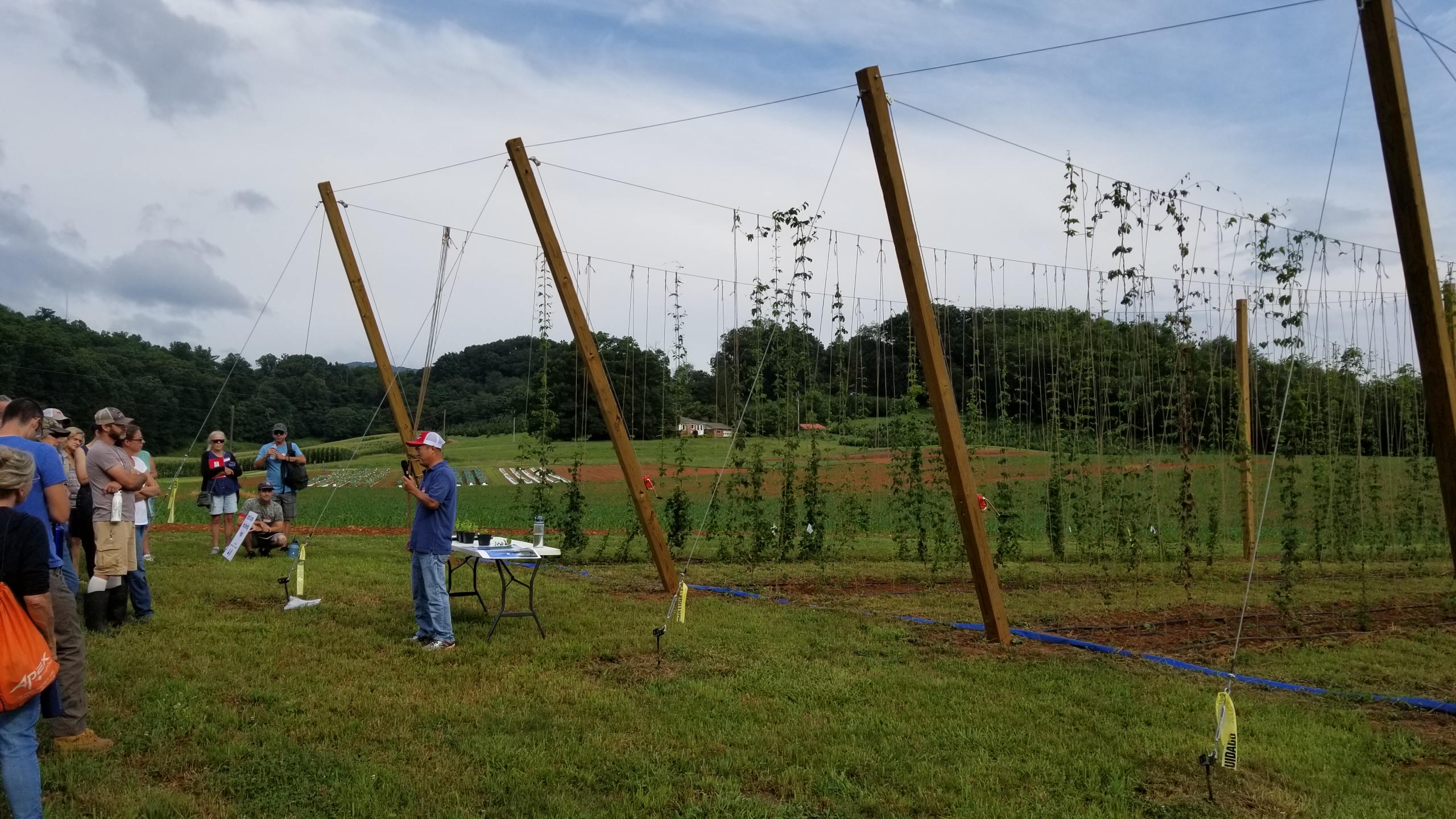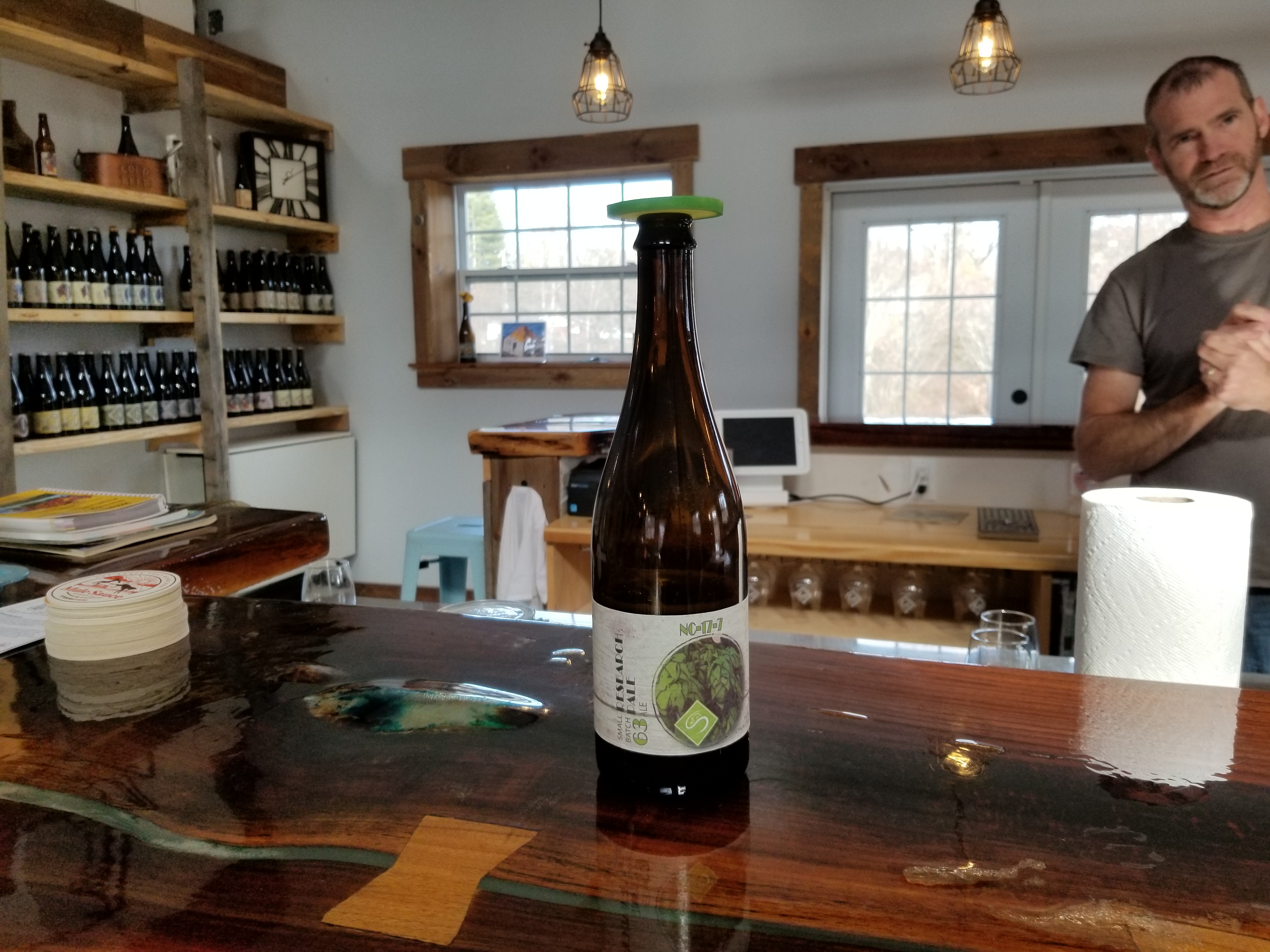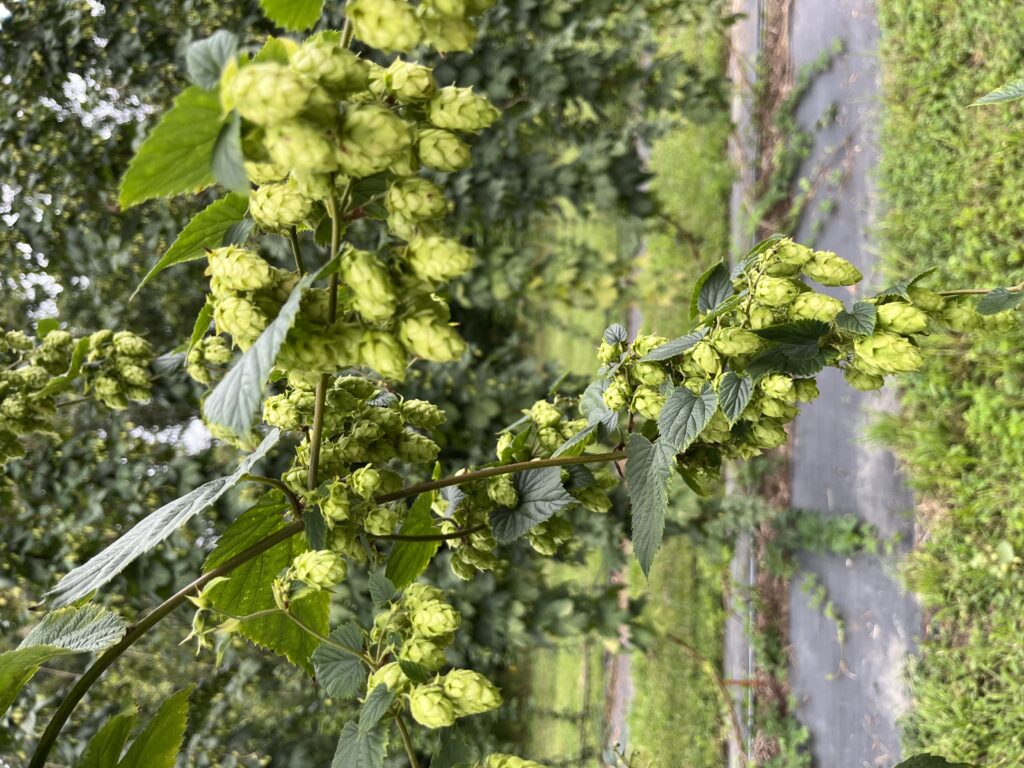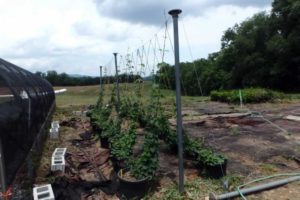Breeding Hop Varieties for North Carolina
go.ncsu.edu/readext?520698
en Español / em Português
El inglés es el idioma de control de esta página. En la medida en que haya algún conflicto entre la traducción al inglés y la traducción, el inglés prevalece.
Al hacer clic en el enlace de traducción se activa un servicio de traducción gratuito para convertir la página al español. Al igual que con cualquier traducción por Internet, la conversión no es sensible al contexto y puede que no traduzca el texto en su significado original. NC State Extension no garantiza la exactitud del texto traducido. Por favor, tenga en cuenta que algunas aplicaciones y/o servicios pueden no funcionar como se espera cuando se traducen.
Português
Inglês é o idioma de controle desta página. Na medida que haja algum conflito entre o texto original em Inglês e a tradução, o Inglês prevalece.
Ao clicar no link de tradução, um serviço gratuito de tradução será ativado para converter a página para o Português. Como em qualquer tradução pela internet, a conversão não é sensivel ao contexto e pode não ocorrer a tradução para o significado orginal. O serviço de Extensão da Carolina do Norte (NC State Extension) não garante a exatidão do texto traduzido. Por favor, observe que algumas funções ou serviços podem não funcionar como esperado após a tradução.
English
English is the controlling language of this page. To the extent there is any conflict between the English text and the translation, English controls.
Clicking on the translation link activates a free translation service to convert the page to Spanish. As with any Internet translation, the conversion is not context-sensitive and may not translate the text to its original meaning. NC State Extension does not guarantee the accuracy of the translated text. Please note that some applications and/or services may not function as expected when translated.
Collapse ▲
Link to Breeding Work in 2016 and 2017
Link to the 2019 Hops Breeding Update
Link to the Hops Breeding Update for 2024
Production Guide for Hops Selection NC1601
Funding for all the studies described below was provided by grants awarded through the North Carolina Department of Agriculture & Consumer Services Specialty Crops Block Grant Program and New and Emerging Crops Program.
Introduction to the Hops Breeding Program-2016 by Luping Qu and Jeanine Davis
Interest and commitment from local growers in establishing commercial hop (Humulus lupulus) production in NC have been strong over the past ten years and this parallels the growth of the craft brewing industry in the state. According to the U.S. Brewers Association in 2016, 24.1 million barrels were produced by craft breweries (31 gal per barrel). North Carolina had 200 (33 in 2008, 101 in 2014) breweries out of a total 5234 in the US in 2016, ranked 9th (12th in 2014) and produced 1,269,402 (185,000 in 2008, 372,473 in 2014) barrels, ranking 5th in the nation and with $ 2.04 billion (1.2 billion in 2014) economic impact in the state.
Over the past twelve years, hop yard acreage in NC has grown from just a few acres to more than 40 acres in 2015 (Hop Growers of America). However, NC growers and NC State University researchers in Mills River and Raleigh have experienced low yields compared to the major hop production areas. Dry cone yield in NC is about one-fifth of that in the Pacific Northwest (PNW) (200 to 400 dried lbs per acre in NC compared to 1,000 to 2,000 dried lbs per acre in the PNW for most popular hop varieties Cascade, Nugget, and Chinook). With yields this low, it is doubtful that NC hop production can be profitable over the long term. The low yield is due to available hop varieties being poorly adapted to NC, which is close to the generally accepted southern geographic limit (latitude 35o N) for successful hop production. These varieties, bred and selected almost entirely from and for the major hop production regions in the PNW, either suffer from poor vegetative growth and/or low flower production (low cone yield) in NC. Adjusting cultivation methods, such as cutting down new growth in spring to delay flower initiation, appears to be able to control the timing of flower initiation but has limited impact on improvement of cone yield.
So, it is clear that without varieties that can adapt well to NC environments, which during the growth season are usually warmer, more humid, and shorter in photoperiod than hop production regions in the PNW, hop production in the state will not grow beyond the niche crop status it has now. Therefore, for long term growth and success of hop production in NC, development of varieties through breeding and selection in its own environments may be the only solution for the establishment of a strong hop industry in the state.
Having germplasm that possesses the genetics for growing well vegetatively and reproductively (producing high cone yield) in NC is the most important and fundamental factor for determining the validity to start and maintain a hop breeding program. Ideal germplasm candidate(s) for this purpose must also have relatively good brewing qualities to yield rapid results. Based on observations from the last several years in our experimental hop yard at the Mountain Horticultural Crops Research and Extension Center in Mills River, NC, we identified a hop variety Canadian Red Vine (CRV) which has performed well in vegetative growth and produced very high cone yields. Cone yield of CRV was impressively high compared to the other varieties included in the trial. One plot of five plants produced 19.3 lbs of fresh cones in the first year (2013) and 25.6 lbs the following year (2014). Its first year yield was more than three times that of the second best producing variety Zeus (3.9 lbs vs 1.1 lbs per plant) in 2011 and the second year yield was close to 4 times of the best variety Nugget (5.1 lbs vs 1.4 lbs per plant) in 2014. However, CRV is currently rarely used in the brewing industry because it has a reputation for having a high cohumulone content, which may cause a harsh aftertaste in the beer.
It is generally believed, and has been evidenced in the practice of hop breeding and cultivation, that the hop plant is very sensitive to day length and local environmental factors such as temperature or soil conditions and, as a result, varieties usually do not perform well outside the original area where they were developed. Therefore, hop improvement programs needed to be in the geographic areas in which the varieties will be grown. CRV was probably developed in Canada (ARS, USDA). Therefore, the origin of this variety suggests that its testing and selection site were not with low humidity and plenty of sunlight during the growth season like that in the PNW. This indicates that the breeding (especially selection) site is very important in development of hop varieties that can adapt to a local or even a broad environment. The important role played by selection site is also evidenced in the breeding of the hop varieties ‘Southern Brewer’ and ‘Southern Promise’ in South Africa. These varieties were developed from crossing the existing hop variety Fuggle in the United Kingdom with unspecified male hops under local conditions in George, South Africa, at a southern latitude similar to NC.
With the background information in mind of high impact on economy and having promising germplasm, we started a breeding project for the purpose of developing hop varieties that will adapt well to the environments of NC and other south Atlantic states with high cone yield, acceptable disease resistance, and good brewing quality. In this project we are breeding and selecting by combining the genetics for plant growth and cone yield from CRV with current commercially important hop varieties such as Cascade, Chinook, and Nugget for new variety development.
Our breeding work started in 2016. The 2016 work was initiated with no funding for the purpose of generating new male and female germplasm for use in further breeding steps, particular for generating males that are selected in NC environments. Plants were grown in pots (≥ 5-gallon) at the Mountain Research Station, Waynesville, NC (Figure 1a). Female parents with aromatic properties (Cascade, Tettnang) and bittering (Columbus, Southern Brewer), and ZR4P1MR (ZM, a dwarf selection) were chosen to cross with a male selection YAW2 (Figure 1b). CRV plants generated from soft cuttings failed to flower in 2016 because they were started late. The male plant (YAW2) flowered in late June and overlapped with the five varieties. Open pollination was performed. Cones appearing to bear seeds were harvested in September to early October 2016, placed in paper bags, and dried at room temperature. Seeds were collected in December 2016 and Jan. 2017. Since only one male was involved, pedigrees of the seeds are known. From these crosses 1,495 seeds were collected.
Seed collection was done by hand. Matured hop seed is covered with lupulin powder, sitting on the peduncle enclosed by a small fold of the bearing bracteole. Cleaned seeds (with no bracteole but is sticky due to lupulin) were put in paper seed envelopes and stored in an environmentally controlled seed storage room until needed.
Before germination, the seeds were stratified under moisture-cold (~40o F) conditions (Figure 2). Seeds were spread on the soil surface in 1-gallon garden containers and covered with 0.5 cm of the soil. The soil was then thoroughly moistened with tap water and placed in a walk-in cooler. The pots were regularly checked and moistened when needed. The stratification lasted for about 8 weeks.

Figure 2. Hop seed stratification in a walk-in cooler at ~40o F.
In 2017, totally 939 seedlings were obtained from these seeds. After initial screening for disease (downy mildew) resistance by growing in four inch pots, about 20% of the seedlings were transferred to 1-gallon pots for further evaluation (Figure 3). From these, six female plants were selected and cuttings were made to grow additional plants. Eleven plants from the cutting were transferred to the hop yard in June 2017 and flowered that season. Seven male plants were also identified in the 2017 population.
Crosses made in the 2017 growth season focused on between CRV and selected males (three 2016 selections of SB-m1, ZM-m1, ZM-m2, and YWA2) through open pollination. By October 2017, >3,000 seeds were collected from these crosses. On November 6, 2017, 110 seedlings obtained from first batch of 239 seeds and were transferred to 4 inch pots and grown in a greenhouse. On December 4-5 2017, 72 seedlings were repotted into 1-gallon pots and trained on to strings in a low trellis system in the greenhouse. These plants grew up to 9 feet high with 16 nodes in about 40 days (Figure 4). Burr stage was observed on a seedling on Jan. 23, 2017. Additional seedlings will be developed in the coming months.

Figure 4. Young Canadian Red Vine plants growing in a greenhouse in Mills River, North Carolina.
In 2018, we are expecting to obtain more than 2,000 seedlings from the CRV crosses and after screening for downy mildew resistance, about 10% will be planted in pots or in soil for evaluation. Selected female plants will be propagated by soft cuttings for increasing plant numbers for evaluation in next growth season. Male plants with disease resistance and flowering time (prefer late flowering) will also be selected for use in breeding.
Crossing back these selected males with hop varieties will increase the chance for the progeny to possess more good traits of the established varieties and less of the undesired characters from CRV. In 2018, we are going to use several selected hop varieties in such crosses.
At a latitude of 35.58o N, Mills River is close to the southern limit of regions considered suitable for successful hop production. Because of high elevation (2,425 feet) of the trial site, we have a relatively cooler summer than at lower elevation areas at the same latitude. However, compared to the Yakima Valley (Yka) in WA, our location still appears to be less favorable for promoting hop growth and cone yield (Table 1). During the growing season from April to September, our site has a similar day-high temperature but much higher night-low temperature than the Yka, which may have negative impact on nutrition accumulation in the plants for growth and reproductive production as have been seen in other crops; during growth season our day length is about 60 min shorter than Yka and our precipitation is >10 times than Yka which means less available sunlight in addition to the shorter day length because of more cloudy/rainy days.

Except CRV, all the hop varieties we grew in Mills River performed poorly compared to when they are grow in the PNW. Most of the varieties did not grow to the desired height and the ones that reached the height developed less flowers and/or short side arms, on which hop cones are borne (Table 2). Therefore, low yields were produced by these varieties (Figure 5).
However, vegetative and reproductive growth of CRV appeared not be affected in Mills River. The plant grew on average of about 0.5 feet a day and reached 20 feet high in about 40 days before flowering (Figure 6). Its side arm development went along with the main bine’s growth and the length of a side arm was often more than 60 inches with 18 nodes.

Figure 6. CRV plants were cut back to the ground on 4/25/2017 and reached 20 f high on 6/9/2017 in Mills River, North Carolina
Another growth and development feature of CRV is its secondary side arm development on the original side arms (Figure 3). These secondary side arms can develop on up to the 6th nodes counted from the arm base (Figure 7 and b) and up to 24 cones can develop on a single arm.
Written by Luping Qu.
2019 Hops Breeding Update
by Luping Qu

Dr. Luping Qu speaking at a field day in front of the new Waynesville hop yard.
We have made significant progress in our hop breeding program over the last few years. We established a breeding hop yard at the research station in Mills River in 2018 (Figure 1a) and expanded the one at the Mountain Research Station in Waynesville in 2019 (Figure 1b). We have used these hop yards to screen first year hybrid seedlings and make initial selections.

Figure 1a. Breeding hop yard in Mills River.

Figure 1b. Breeding hop yard in Waynesville.
We made selections in 2018 and 2019. Compared to the hop varieties that most growers produce in our region, these selections produced higher yields and exhibited moderate downy mildew resistance (an important trait for this region). Brief descriptions of our four advanced selections are provided in Table 1.

Table 1. A brief description of hop selections made in our breeding program in 2017-2018. WA third year plant, 2 strings with 3 bines each on 18’ trellis. W1Average of first year plants; XAverage of first year plants, 2 strings with 2-3 bines/string on 15’ trellis; YAverage of first year plants, 2 strings with 2-3 bines/string on 15’ trellis. ZAverage of first year plants, 2 strings with 2-3 bines/string on 15’ trellis.
We propagated these advanced selections in 2019 and transplanted the propagules in the hop yards in May. The plants flowered in early to mid-June. Cones were hand harvested in late August to early September. Yields from our variety trials and those reported by growers in NC and VA are in the 300-500 dried lbs/acre range. Estimated yields from our new selections are more than three times what we usually harvest from Cascade, the most widely grown variety in the region

Figure 2a. 3rd year plant of NC1601.

Figure 2b. 1st year plants of NC1701.

Figure 2c. 1st year plants of NC1711.

Figure 2d. 1st year plants of NC1707.

Figure 3a. Hop cones NC1601.

Figure 3b. Hop cones NC1707.
After we collected all of our yield and quality data and submitted samples to the lab for analysis, we provided cones to Sideways Farm and Brewery in Etowah, NC to determine if these selections made good beer.
Jon Schneider, master brewer at Sideways, used two selections to make single hop beers. Here are his comments: “Brewing with the two new varietals of hops developed by the NC State [Research and] Extension center at Mills River has been an amazing honor. NC-1707 gave the beer a wonderful aroma of ripened tropical fruit and will make for a wonderful dual purpose hop. NC-1601 has a slight piney and floral aroma and will be a great bittering hop addition. Both of these varietals are an amazing achievement for the [Research and] Extension center as well as the local craft beer industry.”

Figure 4. Jon Schneider of Sideways Brewery with research beer.

Figure 5. Research beer.

Figure 6. Research beer label.
These results indicate that we have made significant progress in breeding hops for lower latitudes. We will continue our breeding to increase yield, quality, and disease resistance and conduct more on-farm trials and tests with breweries.
Hops Breeding Update for 2024
by Luping Qu
Our breeding has been focused on developing new aroma hop varieties. Since 2019, we have conducted in-field evaluations of our hop selections and worked with local breweries to brew test beers with these selections. Results show that our hop selections can produce yields that are comparable to the yields that hop aroma varieties produce in the Pacific Northwest (PNW) and brew beers with good quality according to the feedback from brewers and consumers.
| Selection |
Side arm length (inches) |
Secondary side arms present |
Potential yield (dried lbs/acre) |
| NC01* |
20-40 |
Yes |
1,600-2,000 |
| NC02 |
20-30 |
Yes |
1,400-1,800 |
| NC03 |
20- 50 |
Yes |
1,400-1,800 |
| NC04 |
20-60 |
Yes |
1,400-1,800 |
*the selection “names” are for use in this publication only. Other identifiers are being used in the breeding program.
NC01
NC01 is a vigorous plant that can grow more than 20 feet tall on the trellis (Figure 1 top and bottom). Its side arms are 20 – 40 inches long. NC01 also produces secondary side arms (Figure 1 middle). In most cases, the hop varieties developed in the PNW don’t produce secondary side arms when grown in North Carolina. With secondary side arms, a hop plant can produce a higher yield. NC01 produces medium to large cones. The harvest time window for NC01 in Mills River is mid-August to mid-September.

NC01 plants at early stage of flowering.

Secondary side arms on NC01.

NC01 at late stage of cone development.
Figure 1. Top: NC01 plants at early stage of flowering, middle: secondary side arms of NC01, and bottom: NC01 at late stage of cone development.
NC02
NC02 is a selection with relatively short side arms. It is not as vigorous as NC01 but has shorter internodes and a good yield structure by producing tertiary side arms (Figure 2). The harvest time window for NC01 in Mills River is mid-August to mid-September.

NC02 is a little shorter than NC01.

NC02 produces primary, secondary, and tertiary side arms where the cones are produced.
Figure 2: Top: NCO2 is a little shorter than NC01 but (bottom) produces primary, secondary and tertiary side arms where the cones are produced.
NC03
NC03 is a vigorous selection with a large canopy and root system (Figure 3 top). It produces beautiful cones (Figure 3 bottom). Compared to the other selections, the plants are more difficult to separate at harvest making cone harvest more time consuming. The harvest time window for NC01 in Mills River is mid-August to mid-September.

NC03 is a vigorous plant.

NC03 produces large, beautiful cones.
Figure 3: Top: NC03 is a vigorous plant and (bottom) produces large, beautiful cones.
NC04
NC04 grows very vigorously and produces side arms up to 60 inches long (Figure 4)! It produces smaller cones than the other selections. The harvest time window for NC01 in Mills River is mid-August to mid-September.

NC04 is a very strong, vigorous plant.

NC04 has very long side arms loaded with cones.
Figure 4: Top: NC04 is a very strong, vigorous plant with (bottom) very long side arms loaded with cones.










